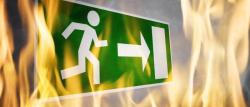 A massive London apartment fire that killed at least 80 people last June is causing landlords to reassess fire risk and potential liability.
A massive London apartment fire that killed at least 80 people last June is causing landlords to reassess fire risk and potential liability.
Officials trace the likely genesis of the Grenfell Tower fire to a faulty refrigerator. But the use of Reynobond PE, an exterior building cladding made by Pittsburgh-based Arconic, Inc., may have contributed to the rapid spread of the fire from floor to floor around the building’s exterior.
The cladding consists of thin sheets of aluminum on either side of a core of polyethylene, a flammable plastic. Despite being illegal for use on high-rise projects in the United States, it’s estimated that thousands of buildings in the US also have the cladding.
It’s already been implicated in another fire at the Lacrosse tower in Melbourne, Australia, in 2014, and possibly in other apartment building fires in France and the United Arab Emirates.
“We have this issue all over Europe, we have this issue in the US, and in Asia and the Middle East,” said Didier Schutz, an engineer with SCOR, a global reinsurance company, who presented a session on combustible exterior wall assemblies at the National Fire Prevention Association (NFPA) annual conference in 2016. “It’s a worldwide problem,” he added.
While Arconic has discontinued the sale of the particular building cladding in question for high-rise projects, landlords should take care to ensure that their buildings don’t have hazardous, flammable siding materials installed from years ago.
Specifically, all cladding should comply with the provisions of NFPA 285 – a rule from the NFPA adopted under the International Building Code that regulates the use of combustible materials in non-load-bearing siding.
Flammable materials in houses, small apartments
Smaller landlords, too, should take care to ensure their buildings are constructed with fire-resistant materials.
While vinyl siding is generally considered to be flame-resistant itself, it can melt if there is a fuel source such as shrubbery very near to the building – leaving the wall exposed.
Landlords can take steps to ensure the entire building is constructed with tenant safety in mind.
For example:
• Ensure any vinyl or aluminum siding is sealed at the base, to keep flames out of the gap between the siding and the wall.
• Cover vents and openings with 1/8” metal mesh to keep burning embers out of the home.
• Separate wooden fences from the home with brick or stone barriers.
• Use composite material to build decks.
• Install tempered dual-pane windows.
• Avoid wooden shake and shingle roofs. Use non-flammable roofing materials:
o Metal shingles
o Clay or cement tiles
o Asphalt
o Cementitious composite.
• Ensure gutters and roofs are clear of debris.
• Use plaster, stucco, stone or brick exterior walls.
• Conduct maintenance on furnaces.
• Check all fire and smoke alarms. Replace batteries in accordance with manufacturer recommendations.
• Consider rewiring old homes. Prioritize electrical upgrades in your renovation plans.
• Don’t use high-wattage bulbs in recessed fixtures.
• Replace old or untreated cellulose insulation with fiberglass or mineral wool.
• Check chimneys and caps for birds’ nests and other debris.
• Keep vegetation well away from the home.
• Don’t run extension cords under carpets.
• Use solid lumber, fire-resistant fiberglass or composite materials. Particle board is more flammable.
• Ensure secondary escape routes are not blocked by clutter or debris.
For more information on fire safety in home construction and renovation, visit NFPA.org.